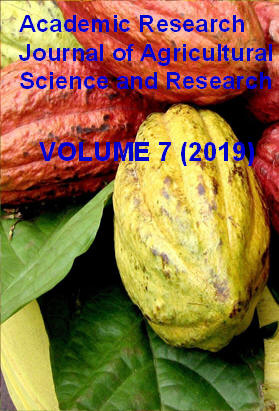|
ISSN: 2360-7874 |
Academic Research Journal of
Agricultural Science and Research |
|||||||||||||||||||
|
Vol. 7(7), pp. 539-551, November 2019 Research GENOTYPE X ENVIRONMENT INTERACTION BY AMMI AND GGE-BIPLOT STABILITY ANALYSIS IN GRAIN YIELD FOR SOYBEAN [(Glycine Max L.) Merrill] IN ETHIOPIA
Mesfin Hailemariam1* and Abush Tesfaye2
1Ethiopian Institutes of Agricultural Research, Jimma Agricultural Research 2International Institutes of Tropical Agriculture, PMB 5320, Oyo Road 200001, Ibadan, Nigeria *Corresponding Authors: Mesfin Hailemariam, Ethiopian Institutes of Agricultural Research, Jimma Agricultural Research, P.O. Box, 192, Jimma, Ethiopia
Accepted 11 November 2019
In
multi-location trials (MET), test environments need to be identified.
properly in order to discriminate between varieties and to be
representative of the targeted agro-ecologies. Hence, this experiment
was conducted with the objectives was to evaluate the GEI using AMMI and
GGE-biplot analysis for grain yield of soybean genotypes and identify
stable genotypes in the different soybean agroecologies of Ethiopia.
Twenty-four soybean genotypes were planted at six soybeans agroecologies
of Ethiopia with RCBD in three replications in 2015/2016 cropping
season. In addition, the first two IPCAs are significant and accounted
for 70.34 form a total of interaction sum squares. Stability measures
viz., Additive Main Effects and Multiplicative Interactions (AMMI), AMMI
stability value (ASV), and Genotype plus GEI (GGE) bi-plot analysis were
used to identify the high yielding and stable genotypes across the
testing environments. AMMI1 biplot showed Pawe is ideal environment;
Bako is favorable environment; Asosa average environment; and the rest
environments viz., Dimtu, Jimma, and Metu as unfavorable environments.
Whereas AMMI-2 biplot analysis genotypes Prichard, Spry, Delsoy 4710 and
Croton 3.9 were identified as stable genotypes. Bako and Metu were
identified as the most discriminating environments. Mega environments
and the best yielding soybean genotypes on each mega environment were
revealed by GGE bi-plots analysis model. The genotypes SCS-1 and AGS-7-1
were stable across soybean growing environments and it recommended for
mega environment production.
How to cite this article (APA Style): Mesfin H., Abush T (2019). GENOTYPE X ENVIRONMENT INTERACTION BY AMMI AND GGE-BIPLOT STABILITY ANALYSIS IN GRAIN YIELD FOR SOYBEAN [(Glycine Max L.) Merrill] IN ETHIOPIA. Acad. Res. J. Agri. Sci. Res. 7(7): 539-551
|
|||||||||||||||||||
